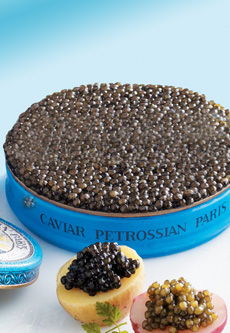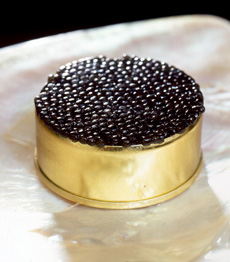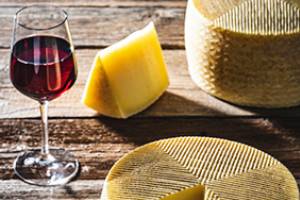
 For years, Petrossian has been the king of Russian caviar. Photo courtesy Petrossian.com.
May 2005
Last Updated November 2025
|
 |
Caviar Glossary
Page 8: Russian Caviar & Other Terms With R
This is Page 8 of a ten-page glossary. If you’d like to suggest additional words for inclusion or think we should consider other definitions than those we have provided, use the Contact Us link on this page. You may also enjoy one of our 60+ other food glossaries.
Click on a letter to get to the appropriate glossary page.
a b c d e f g h i j k l m n o p q r s t u v w x y z
This material is copyrighted and cannot be reproduced in whole or in part
without written permission.
RAINBOW TROUT CAVIAR
See trout caviar.
RED CAVIAR
A term sometimes used for salmon caviar, although other fish roes such as masago and tobiko are also red in color.
RIVER BELUGA CAVIAR
This is a trademarked name and more than a little misleading—it implies that the caviar comes from beluga sturgeon raised in a river. However, it is not from the Huso huso, or beluga sturgeon. River Beluga caviar comes from the Huso dauricus or kaluga sturgeon. Sellers claim that River Beluga Caviar has a large dark amber pearl with a taste as smooth and buttery as Caspian Beluga Caviar (at $200 an ounce compared to $230 for Beluga, we hope so!). See kaluga sturgeon for more information.
ROE
The eggs of a fish, also called berries, pearls, and grains. In addition to sturgeon roe, roe from several different species of fish is enjoyed by consumers: keta roe from the keta salmon; masago from the smelt, tobiko from the Icelandic flying fish, avruga from the Spanish herring, plus American caviars (roes) from the bowfin, lumpfish, paddlefish, trout, and whitefish. In the caviar trade, once the roe has been salted, it becomes caviar.
RUSSIAN CAVIAR
Russian caviar is caviar that is harvested in Russia, from any species of sturgeon. “Russian caviar” used to recall the great Caspian sturgeons: Beluga, Osetra, and Sevruga. However, each of these great fish is on the World Wildlife Foundation’s Endangered Species List. Thus, while countries that border the Caspian are allowed to fish for them and use them for domestic (non-export) purposes, there may soon be no fish left to capture (see Caspian Sea). Today, some non-Caspian sturgeon, specifically the Russian Sturgeon (Acipenser gueldenstaedtii, the same species as the Caspian Osetra living elsewhere) and the Siberian Sturgeon (Acipenser baerii baerii, a cousin of the Osetra), are still caught wild in rivers of the continent.
|
|

Siberian Osetra Malossol. Available at CaviarRusse.com. |
These sturgeon are also farmed, everywhere from Bulgaria, Italy, and Israel to France, Germany, and Uruguay. While the Russians developed the caviar industry that we know today, perfecting their processing methods through generations, the Russian caviar industry itself is currently in a huge decline due to drastic over-fishing and pollution of sturgeon in the Caspian Sea (abetted by internal political turmoil).
Continue To Next Page: Caviar Terms With S
Go To The Article Index Above
Lifestyle Direct, Inc. All rights reserved. Images are the copyright of their individual owners.

|




 For years, Petrossian has been the king of Russian caviar. Photo courtesy Petrossian.com.
For years, Petrossian has been the king of Russian caviar. Photo courtesy Petrossian.com.